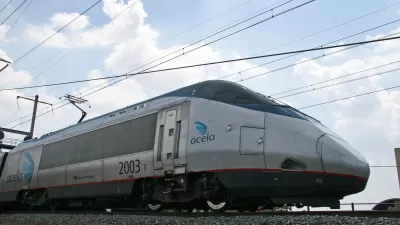The state has the chance to apply for a piece of $2.3 billion in federal funding to improve and expand Amtrak service.

With $2.3 billion in federal funding for passenger train service on the line, it remains unclear whether the state of Ohio will apply for a portion of the money. According to an article by Susan Glaser of Cleveland.com in Governing, Ohio Governor Mike DeWine “is awaiting answers to several key questions before making a decision about whether to seek federal money for expanded Amtrak service in the state.”
The governor wants to know how many new riders the service could get, the speed of the trains, how new passenger service would interact with existing freight service, and how much state funding would be required.
As Glaser explains, “This $2.3 billion is the first available for expanded intercity passenger rail service, part of a program to bring new routes to areas of the country that are underserved by train transportation.”
Ohio residents currently have limited access to intercity trains. Glaser notes, “There hasn’t been passenger rail service between Cleveland, Columbus and Cincinnati since the early 1970s.” This route was recently identified as a top priority by Amtrak. “Twelve years ago, under former Gov. Ted Strickland, the state received $400 million in federal funding to launch the 3-C route. Shortly after taking office, however, newly elected Gov. John Kasich famously returned the money to Washington because he was opposed to state support for passenger rail service.”
FULL STORY: With Amtrak Funds Now Available, Will Ohio Expand Rail Service?

Study: Maui’s Plan to Convert Vacation Rentals to Long-Term Housing Could Cause Nearly $1 Billion Economic Loss
The plan would reduce visitor accommodation by 25,% resulting in 1,900 jobs lost.

North Texas Transit Leaders Tout Benefits of TOD for Growing Region
At a summit focused on transit-oriented development, policymakers discussed how North Texas’ expanded light rail system can serve as a tool for economic growth.

Why Should We Subsidize Public Transportation?
Many public transit agencies face financial stress due to rising costs, declining fare revenue, and declining subsidies. Transit advocates must provide a strong business case for increasing public transit funding.

How to Make US Trains Faster
Changes to boarding platforms and a switch to electric trains could improve U.S. passenger rail service without the added cost of high-speed rail.

Columbia’s Revitalized ‘Loop’ Is a Hub for Local Entrepreneurs
A focus on small businesses is helping a commercial corridor in Columbia, Missouri thrive.

Invasive Insect Threatens Minnesota’s Ash Forests
The Emerald Ash Borer is a rapidly spreading invasive pest threatening Minnesota’s ash trees, and homeowners are encouraged to plant diverse replacement species, avoid moving ash firewood, and monitor for signs of infestation.
Urban Design for Planners 1: Software Tools
This six-course series explores essential urban design concepts using open source software and equips planners with the tools they need to participate fully in the urban design process.
Planning for Universal Design
Learn the tools for implementing Universal Design in planning regulations.
Ascent Environmental
Borough of Carlisle
Institute for Housing and Urban Development Studies (IHS)
City of Grandview
Harvard GSD Executive Education
Toledo-Lucas County Plan Commissions
Salt Lake City
NYU Wagner Graduate School of Public Service





























